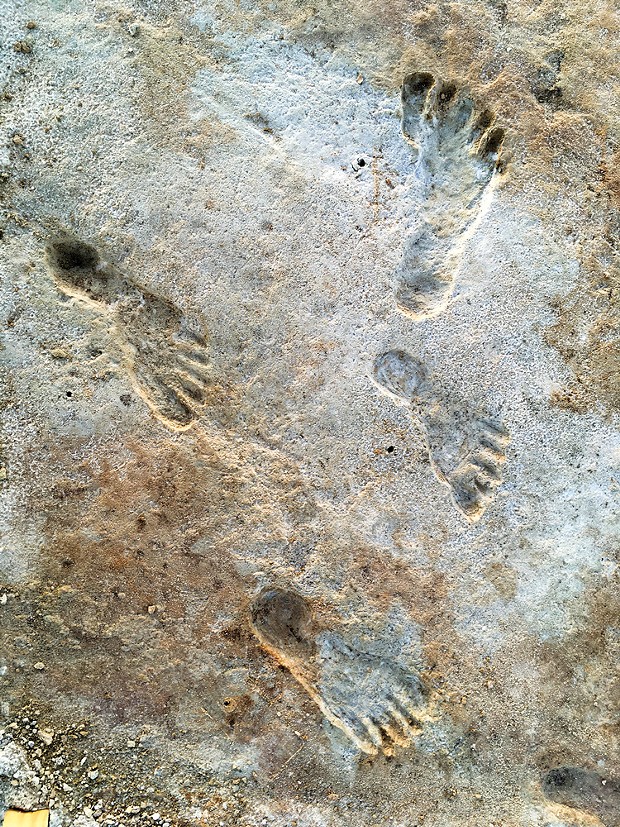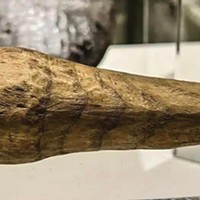
Courtesy of the National Park Service
Fossilized footprints of children and teenagers from more than 20,000 years ago, found in New Mexico's White Sands National Park.
[
{
"name": "Top Stories Video Pair",
"insertPoint": "7",
"component": "17087298",
"parentWrapperClass": "fdn-ads-inline-content-block",
"requiredCountToDisplay": "1"
}
]
Anyone with even a passing interest in the peopling of the Americas will know that the Clovis First hypothesis has long been put to rest. The idea — that the first humans to come to the "New World" arrived around 12,500 years ago were the same people who fashioned fluted stone Clovis points (after Clovis, New Mexico) for the tips of their spears and arrows — died with the discovery of many older archaeological sites in both North and South America.
The first of these was the Monte Verde site in southern Peru, which anthropologist Tom Dillehay of Vanderbilt University has been excavating since 1977. He and his team have found charcoal remains and charred animal bones, indicating human settlement, which have been carbondated to 18,500 to 14,500 years old. Another, somewhat local pre-Clovis site is Paisley Cave in south-central Oregon, where human coprolites (fossilized feces) have been dated to around 14,300 years ago. While these and another 20-odd pre-Clovis sites in the Americas show definite signs of human habitation, almost no human bones have been found, leading skeptics to point out that purported tools and cut marks on bones could be explained away by natural processes. So, where's the unequivocal evidence?
It arrived last September, with the next best thing to human remains: human footprints. The journal Science published a paper in which the 15 authors contend that human footprints found in eight layers of exposed outcrops in New Mexico's White Sands National Park were made on a lakeshore between 23,000 and 21,000 years ago. The footprints are undoubtedly human — no other creature leaves the prints like those shown in the photo — and were probably left by young children and teenagers. Another set of prints seem to show a mother walking with a young child before she picks up and carries the youngster, first on one side of her body, then the other side.
Today, the park is known for its white gypsum dunes stretching for hundreds of square miles, but during a warm period in the middle of the last Ice Age, the area was a grassy plain with a lake the size of Rhode Island. The tracks from different strata show that humans lived alongside the lake for at least 2,000 years, probably for the hunting opportunities. In addition to giant sloths, researchers have found tracks of ancient camels, mammoths, dire wolves and saber-toothed cats.
So, what's the unequivocal evidence, since the prints themselves, first found in 2009, can't be directly dated? The excavators found hundreds of seeds of Ruppia cirrhosa, better known as spiral ditchgrass, above, below and, in some cases, embedded in the footprints. Using carbon dating, the seeds have been shown to range between 21,000 and 23,000 years old, with the oldest ones lowest, as would be expected in the absence of any disturbance or contamination.
I discussed in an earlier Field Notes ("Go East, Young Man," June 14, 2012) evidence that the earliest inhabitants of the Americas paddled along the southern coast of Alaska and down the Pacific Coast, rather than walking across Beringia (the ancient land between Siberia and Alaska when the sea level was much lower than today). Because the overland route was blocked by thick ice sheets during much of the last Ice Age, the White Sands footprints lend credence to the sea route hypothesis. Now if only we could find the bones of the kids who left those footprints, especially if those bones contained recoverable DNA. The "first in the Americas" story is far from over.
Barry Evans (he/him, [email protected]) is coming back as an archaeologist. Or an astronomer.
Speaking of...
-

A Brief History of Dildos
Apr 11, 2024 - More »
more from the author
-
The Myth of the Lone Genius
- Jun 6, 2024
-
mRNA Vaccines vs. the Pandemic
- May 23, 2024
-
Doubting Shakespeare, Part 3: Whodunnit?
- May 9, 2024
- More »
































